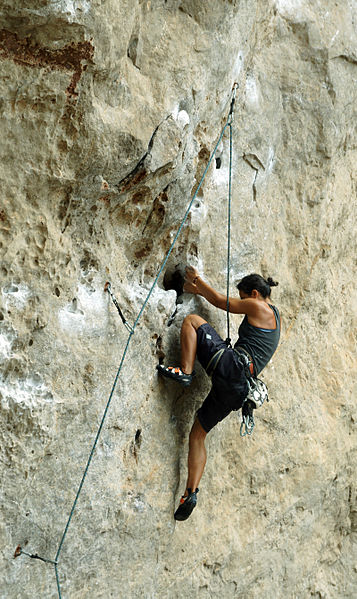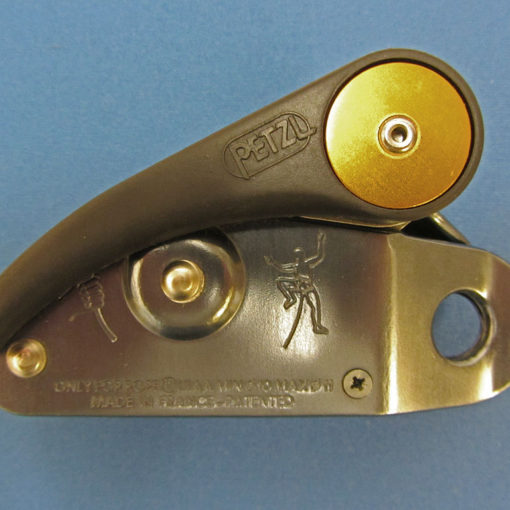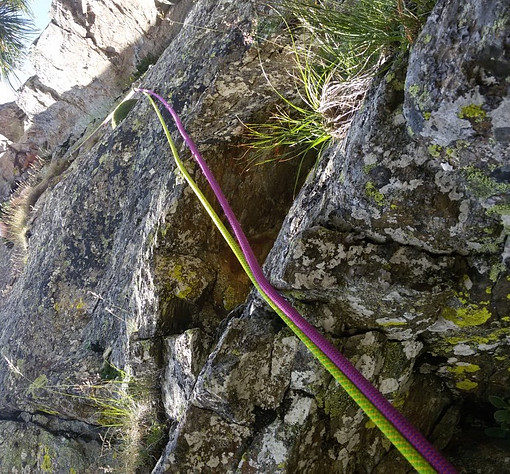You may have heard the term “trad” in rock climbing and wonder what is trad climbing? Trad is short for traditional. It is a style of lead climbing where a climber places protective gear to protect against falls. The gear then can be removed when a pitch is completed. A pitch is a section of a route that is climbed between two belay points. We generally use 50 to 80-meter rope for one pitch.
Trad climbing is an advanced style and technique for outdoor climbing. It is challenging and risky if you do not know what you are doing. I would highly recommend hiring a guide or practice with an experienced climbing friend before you attempt trad climbing on your own if you are new to trad climbing.
In this article, we will discuss the basic needs of trad climbing. You will want additional rock climbing gear, learn how to place the protective gear and anchor, and know your knots for trad climbing.
As the owner of this website, I tracked down special deals for some products or services mentioned herein. As an Amazon Associate, I earn from qualifying purchases. When you use the link from this page to make a purchase, I may receive a small commission to support this website, and you may receive a great bargain – Full Disclosure.
Trad Climbing vs Sport Climbing
![By kallerna [CC BY-SA 3.0 (https://creativecommons.org/licenses/by-sa/3.0)], from Wikimedia Commons 357px-Rock_climber_Phra_Nang_1](https://rockclimbingforwomen.com/wp-content/uploads/2018/08/357px-Rock_climber_Phra_Nang_1-179x300.jpg) Before we move forward into trad climbing, I would like to clarify the different styles of lead climbing. There are two styles of lead climbing: sport and trad. When I started to lead climbing outdoor, I did not even know that there were different styles. I thought traditional climbing was the same as sport climbing. The only difference was climbing indoor vs outdoor. As I climbed more outdoor, I slowly learned the ropes, literally, so I thought I share them with you.
Before we move forward into trad climbing, I would like to clarify the different styles of lead climbing. There are two styles of lead climbing: sport and trad. When I started to lead climbing outdoor, I did not even know that there were different styles. I thought traditional climbing was the same as sport climbing. The only difference was climbing indoor vs outdoor. As I climbed more outdoor, I slowly learned the ropes, literally, so I thought I share them with you.
You may also have heard of sport climbing as well as trad climbing. Sport climbing is also another style of lead climbing where bolts for anchors are already in place. The climbers do not have to place their own protective gear into the rocks. The climbers need only quickdraws to clip them into an existing bolt as an anchor to protect against falls. It is less risky than trad climbing. Trad climbing depends on the good placement of the protective gear as anchors. The last thing you would want is for the gear to slip out of the rock or crack.
Sport climbing can be done outdoor and indoor whereas trad climbing can be done only outdoor. You will need additional gear for trad climbing than you would for sport climbing. So you may wonder, why do more people want to do trad climbing rather than sport climbing?
Trad climbing opens to new and more challenges. There are many more routes available for trad climbing than sport climbing. We want to preserve the natural rock formation of the mountain so not all routes would have bolts screwed in. One of the mantras for rock climbers is to “leave no trace behind”. There are also a lot more routes that are still waiting to be discovered by climbers that will require trad equipment.
Protective Gears
Trad climbing requires a complex set of gear for protection to stop a fall. It is called a “pro”. This pro is placed in cracks and fissures as you climb up. It is then removed or cleaned when done leaving only chalk marks behind.

There are two types of gear: active gear and passive gear. The active gear is cams and Big Bros. They are active gear because there are moving parts when triggered. The cam is a mechanism that expands to fill the crack when the trigger is pulled. They are spring-loaded to hold the cam in place when it’s unweighted. The cams vary at different sizes from 3″ down to 0.5″ and smaller. They are great for different size cracks.
The big Bro is a small tube designed for wide cracks called “off-width” or large pockets or holes where other cams are too small. It has two

telescoping tubes that expand after trigger to push against opposite sides of a crack. During a fall, a basic camming action wedges the tube into its place.
The passive gear is nuts, hexes, and tricams. The nuts are made out of aluminum and designed for smaller cracks. They rely on constriction in the crack to create a barrier that keeps it in the rock. The standard placement only protects a downward pull.

The hexes are larger than the nuts. It is made of hollow blocks of aluminum. They are good for medium to wide cracks. They were available before the cams were invented. However, many climbers prefer cams. The hexes are lighter, cheaper, and better security in wet or icy cracks.

The tricams are passive pro because there are no moving parts. The sharp point is on one side and the opposite is gently curved to cam against the rock. They make effective parallel-sided cracks and flaring pods.

==> Click Here “Protective Gear” <== an article written by climbing.com regarding trad protective gear in details.
Placement and Anchors
Placing solid gear and building fast anchors are the most important aspect of trad climbing. They can vary upon a specific situation such as the crack size, the orientation, or what gear do you have available.
I found an excellent article by Climbing.com that gives you overall guidance and general rules on how to place the gear and anchors. ==> Click HERE for Gear Placements and Anchors.
Spend some time on the ground and practice finding placements to fit your cams, hexes, or nuts into the different features or cracks on the rocks. Learn how to create a solid anchor.
The anchors are built with a checklist principle to help us evaluate our handy work accordingly keeping us safe and secure while rock climbing. The checklist is SERENE an acronym for Solid, Efficient, Redundancy, Equalized, No Extension.
Here is another article for building a SERENE anchor from AmericanAlpineClub.org.
Always have a backup for the anchor. If one thing fails, there is always a backup. In addition to the pro, it is good to have slings, loop cordellete, carabiners, and a nut tool. The slings are strongly sewn of nylon or dyneema tape. They are typically varied in size from 60 cm to maybe 240 cm. The slings, cordellete, and carabiners are useful for extending gear and equalizing belays for anchors. The nut tool is great for removing the gear.


This article is only for guidance and information. It is not a replacement for a guide or a knowledgeable trad climber. If you are new to trad climbing, practice and follow an experienced climber before trad climbing on your own.

Knots Commonly Used For Trad
There are a variety of knots required for traditional climbing, to create anchors, to tie in the climbers, and also sometimes used during the climb. I found on Wikipedia.org the common knots used for trad climbing.
- Figure-eight loop – this is the most common knot used to tie in the climbers at the harness.

Figure-eight tie-in
- Clove hitch – this knot is being used when building an anchor
![Markus Bärlocher [Public domain], via Wikimedia Commons Clove hitch](data:image/gif;base64,R0lGODlhAQABAIAAAAAAAP///yH5BAEAAAAALAAAAAABAAEAAAIBRAA7)
Clove Hitch - Alpine butterfly – It is a knot form a fixed loop in the middle of the rope. It is used to tie a climber into the middle of a rope
![Mark A. Taff. http://www.MarkTaff.com [GPL (http://www.gnu.org/licenses/gpl.html) or CC BY-SA 3.0 us (https://creativecommons.org/licenses/by-sa/3.0/us/deed.en)], from Wikimedia Commons Alpine butterfly](data:image/gif;base64,R0lGODlhAQABAIAAAAAAAP///yH5BAEAAAAALAAAAAABAAEAAAIBRAA7)
Alpine butterfly
- Munter hitch – This hitch is used to belay without a belay device.
![By The original uploader was Mark in the wiki at German Wikipedia. (Transferred from de.wikipedia to Commons.) [Public domain], via Wikimedia Commons Munter Hitch](data:image/gif;base64,R0lGODlhAQABAIAAAAAAAP///yH5BAEAAAAALAAAAAABAAEAAAIBRAA7)
Munter Hitch - Slip Knot – It is also known as a running knot. It may be used to sling an object such as a tree that may be on the route.
![By Hadron137 [CC BY-SA 4.0 (https://creativecommons.org/licenses/by-sa/4.0)], from Wikimedia Commons Slip Knot](data:image/gif;base64,R0lGODlhAQABAIAAAAAAAP///yH5BAEAAAAALAAAAAABAAEAAAIBRAA7)
Slip Knot - Lark’s foot or also known as a girth hitch or a cow hitch. It is used to attach slings to trees, spikes, or a climber’s harness.
![By Malta [CC BY-SA 2.5 (https://creativecommons.org/licenses/by-sa/2.5)], from Wikimedia Commons Lark's head or cow hitch](data:image/gif;base64,R0lGODlhAQABAIAAAAAAAP///yH5BAEAAAAALAAAAAABAAEAAAIBRAA7)
Lark’s head or cow hitch
-
- Double figure-eight loop – This loop is used for building a master point of the climbing rope.
![By Arbitrarily0 [CC BY-SA 3.0 (https://creativecommons.org/licenses/by-sa/3.0) or GFDL (http://www.gnu.org/copyleft/fdl.html)], from Wikimedia Commons double figure eight loop](data:image/gif;base64,R0lGODlhAQABAIAAAAAAAP///yH5BAEAAAAALAAAAAABAAEAAAIBRAA7)
double-figure eight loop - Water knot – this knot is commonly used for joining two ends of webbing together when making a sling.
![By David J. Fred (Dfred) [CC BY-SA 2.5 (https://creativecommons.org/licenses/by-sa/2.5)], from Wikimedia Commons water knot](data:image/gif;base64,R0lGODlhAQABAIAAAAAAAP///yH5BAEAAAAALAAAAAABAAEAAAIBRAA7)
water knot - Double bowline – this knot is used for anchoring around a fixed object.
![By The original uploader was Frencheigh at English Wikipedia. (Transferred from en.wikipedia to Commons.) [GFDL (http://www.gnu.org/copyleft/fdl.html) or CC-BY-SA-3.0 (http://creativecommons.org/licenses/by-sa/3.0/)], via Wikimedia Commons Double bowline](data:image/gif;base64,R0lGODlhAQABAIAAAAAAAP///yH5BAEAAAAALAAAAAABAAEAAAIBRAA7)
Double Bowline
- Double figure-eight loop – This loop is used for building a master point of the climbing rope.
My Thoughts on Trad Climbing
There is so much to learn about trad climbing. This article only touched on the basic understanding of this style. The best way to learn is through experience. There are so many things that we need to remember and understand. You do not have to memorize how to tie all the different knots. However, it is important to know as many as possible so that you have options to create solid anchors with the existing equipment or materials from your surrounding. Remember creating redundancy or backup system with safety in mind is good practice in rock climbing.
I have been primarily climbing sport routes outdoor. I climbed a few trad routes which were set up by other experienced climbers. From my experience, the trad routes open up to more possibilities and more challenges that sport routes do not offer. The primary concern for me is the expense of all the trad gear. It gets expensive when you buy everything at once. I am slowly purchasing gear as I need them. I look forward to learning more and have more hands-on experience with trad climbing on my next outdoor adventure.
I love to hear your thoughts. If there are questions, concerns, or comments, please feel free to leave them in the comment box below.




![Markus Bärlocher [Public domain], via Wikimedia Commons Clove hitch](https://s3.amazonaws.com/images.wealthyaffiliate.com/uploads/1090637/sitecontent/be46c7f764a8b48e2c403902f44d4d48_cropped.jpg?1533823959)
![Mark A. Taff. http://www.MarkTaff.com [GPL (http://www.gnu.org/licenses/gpl.html) or CC BY-SA 3.0 us (https://creativecommons.org/licenses/by-sa/3.0/us/deed.en)], from Wikimedia Commons Alpine butterfly](https://s3.amazonaws.com/images.wealthyaffiliate.com/uploads/1090637/sitecontent/96fbfc3fe444303caf3ee180f4dfe2fc_cropped.jpg?1533824157)
![By The original uploader was Mark in the wiki at German Wikipedia. (Transferred from de.wikipedia to Commons.) [Public domain], via Wikimedia Commons Munter Hitch](https://s3.amazonaws.com/images.wealthyaffiliate.com/uploads/1090637/sitecontent/f594d775b70197f54018ab3dc3a7bb97_cropped.jpg?1533824313)
![By Hadron137 [CC BY-SA 4.0 (https://creativecommons.org/licenses/by-sa/4.0)], from Wikimedia Commons Slip Knot](https://s3.amazonaws.com/images.wealthyaffiliate.com/uploads/1090637/sitecontent/e6f933d0d579729b3a1f86d8aea3bb66_cropped.jpg?1533824514)
![By Malta [CC BY-SA 2.5 (https://creativecommons.org/licenses/by-sa/2.5)], from Wikimedia Commons Lark's head or cow hitch](https://s3.amazonaws.com/images.wealthyaffiliate.com/uploads/1090637/sitecontent/3dda983254a5837b4067e37b51818182_cropped.jpg?1533824758)
![By Arbitrarily0 [CC BY-SA 3.0 (https://creativecommons.org/licenses/by-sa/3.0) or GFDL (http://www.gnu.org/copyleft/fdl.html)], from Wikimedia Commons double figure eight loop](https://s3.amazonaws.com/images.wealthyaffiliate.com/uploads/1090637/sitecontent/5a9c20135c48c98391e950c7ef33666f_cropped.jpg?1533824910)
![By David J. Fred (Dfred) [CC BY-SA 2.5 (https://creativecommons.org/licenses/by-sa/2.5)], from Wikimedia Commons water knot](https://s3.amazonaws.com/images.wealthyaffiliate.com/uploads/1090637/sitecontent/a84187c3faf7911697dcf05e166e8615_cropped.jpg?1533825063)
![By The original uploader was Frencheigh at English Wikipedia. (Transferred from en.wikipedia to Commons.) [GFDL (http://www.gnu.org/copyleft/fdl.html) or CC-BY-SA-3.0 (http://creativecommons.org/licenses/by-sa/3.0/)], via Wikimedia Commons Double bowline](https://s3.amazonaws.com/images.wealthyaffiliate.com/uploads/1090637/sitecontent/b2faee4e702f9624f3904a9ee6714518_cropped.jpg?1533825199)



